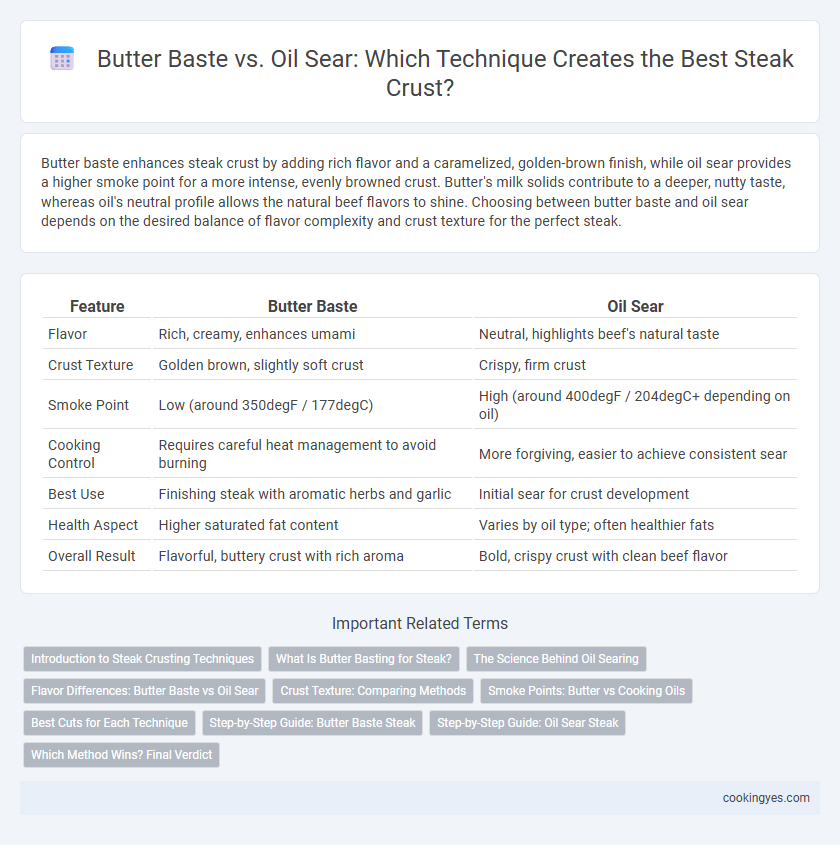Butter baste enhances steak crust by adding rich flavor and a caramelized, golden-brown finish, while oil sear provides a higher smoke point for a more intense, evenly browned crust. Butter's milk solids contribute to a deeper, nutty taste, whereas oil's neutral profile allows the natural beef flavors to shine. Choosing between butter baste and oil sear depends on the desired balance of flavor complexity and crust texture for the perfect steak.
Table of Comparison
| Feature | Butter Baste | Oil Sear |
|---|---|---|
| Flavor | Rich, creamy, enhances umami | Neutral, highlights beef's natural taste |
| Crust Texture | Golden brown, slightly soft crust | Crispy, firm crust |
| Smoke Point | Low (around 350degF / 177degC) | High (around 400degF / 204degC+ depending on oil) |
| Cooking Control | Requires careful heat management to avoid burning | More forgiving, easier to achieve consistent sear |
| Best Use | Finishing steak with aromatic herbs and garlic | Initial sear for crust development |
| Health Aspect | Higher saturated fat content | Varies by oil type; often healthier fats |
| Overall Result | Flavorful, buttery crust with rich aroma | Bold, crispy crust with clean beef flavor |
Introduction to Steak Crusting Techniques
Butter baste enhances steak crust by imparting rich flavor and promoting Maillard reaction through its milk solids, resulting in a caramelized, aromatic surface. Oil sear offers higher smoke points, allowing intense heat for a robust crust without burning, preserving juiciness within. Combining both methods often yields optimal texture and depth, balancing flavor complexity and crust development.
What Is Butter Basting for Steak?
Butter basting for steak involves spooning melted butter over the meat while cooking to enhance flavor and create a rich, golden crust. The butter's milk solids caramelize, contributing to a deeper, more complex taste compared to oil searing alone. This technique also helps keep the steak moist and adds a subtle nutty aroma, elevating the overall steak crust experience.
The Science Behind Oil Searing
Oil searing creates a better steak crust due to its higher smoke point compared to butter, allowing the steak to reach optimal Maillard reaction temperatures without burning the fat. This chemical reaction forms complex flavor compounds and a crispy, caramelized crust essential for steak's savory taste. The precise control of heat during oil searing ensures a consistent golden-brown exterior while preserving juiciness inside.
Flavor Differences: Butter Baste vs Oil Sear
Butter baste imparts a rich, nutty flavor and enhances the steak's natural juices by infusing it with browned butter and herbs during cooking. Oil sear, often using high smoke point oils like avocado or grapeseed, creates a more neutral, crisp crust that emphasizes the steak's char and texture. The choice between butter baste and oil sear directly affects the depth and intensity of the steak's flavor profile, with butter providing more complexity and oil highlighting the meat's seared caramelization.
Crust Texture: Comparing Methods
Butter baste creates a rich, golden-brown crust with a slightly sweet flavor due to the milk solids caramelizing during cooking, enhancing crust texture with a tender, moist finish. Oil sear, especially using high smoke point oils like grapeseed or avocado, produces a deeply crispy and robust crust by allowing higher temperatures without burning. Combining butter basting with a high-heat oil sear can optimize crust texture by balancing crispiness and flavorful tenderness.
Smoke Points: Butter vs Cooking Oils
Butter has a lower smoke point around 350degF (175degC), which can cause it to burn quickly during high-heat searing, creating a bitter crust on steak. Cooking oils like avocado or canola have higher smoke points ranging from 400degF (204degC) to 520degF (271degC), allowing for a more stable sear and a crispier crust. Choosing oils with higher smoke points helps achieve a better Maillard reaction without the risk of burnt flavors that butter may introduce.
Best Cuts for Each Technique
Ribeye and New York strip steaks develop an exceptional crust when butter-basted due to the rich fat content that allows for even browning and enhanced flavor absorption. Leaner cuts like filet mignon benefit more from oil searing, as high-smoke point oils create a crisp, caramelized exterior without risking burnt butter flavors. Choosing the right technique based on the cut's marbling ensures a superior crust and a perfectly cooked steak.
Step-by-Step Guide: Butter Baste Steak
Start by heating a heavy skillet over medium-high heat and adding oil with a high smoke point, such as canola or grapeseed oil, to sear the steak and develop a deep brown crust. Once the steak is flipped, add a few tablespoons of unsalted butter along with aromatics like garlic and thyme, then continuously spoon the melted butter over the steak to enhance flavor and create a rich, golden crust. This butter baste method not only intensifies the savory taste but also locks in moisture, delivering a tender and juicy steak with an irresistible, buttery finish.
Step-by-Step Guide: Oil Sear Steak
To achieve a perfect steak crust using oil sear, heat a high smoke point oil such as canola or avocado oil in a heavy skillet over medium-high heat until shimmering. Pat the steak dry and season it generously before placing it in the hot pan without moving for 3-4 minutes, allowing a deep, flavorful Maillard crust to form. Flip the steak and sear the other side for an additional 3 minutes, then finish with a pat of butter for enhanced flavor, basting gently for a rich, caramelized exterior.
Which Method Wins? Final Verdict
Butter baste creates a rich, flavorful crust on steak by infusing it with creamy, nutty notes and browning proteins more evenly at moderate heat. Oil sear offers higher smoke points with less risk of burning, producing a crispier, more pronounced crust ideal for high-heat searing. For the ultimate steak crust, combining oil sear for initial high-temp caramelization followed by butter basting for flavor depth wins as the best method.
Butter Baste vs Oil Sear for Steak Crust Infographic

 cookingyes.com
cookingyes.com